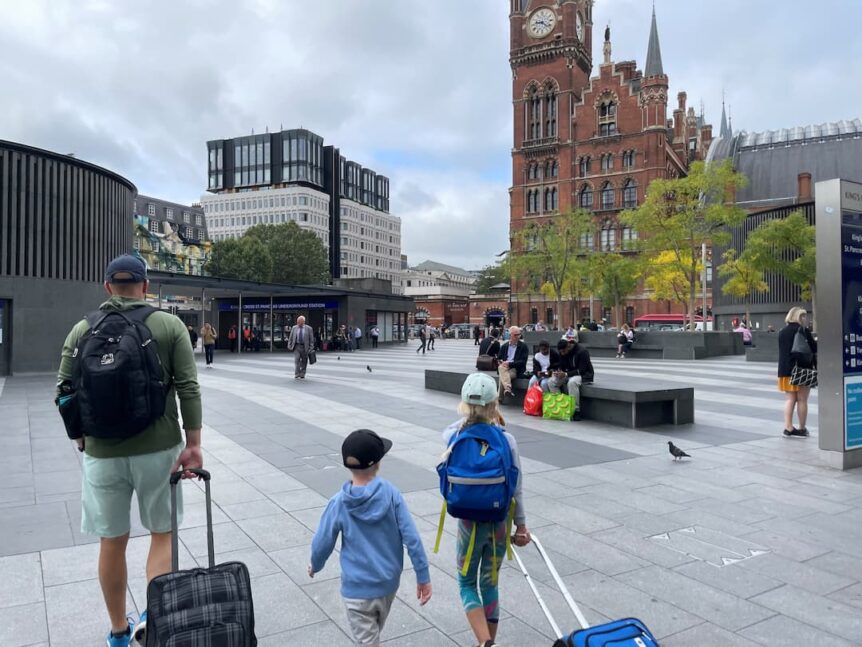
Blog #13 Train vs Plane: why staying grounded is the best solution
In my last blog, I talked about our family’s summer travels to the UK and Europe. We took a Slow Travel approach to both leisure and business, with a focus on sustainable and responsible travel.
So, when I went from the UK to Germany to visit my long-time pen pal, we chose to go by rail rather than air. Rail was more expensive and took longer, but the alternative – four seats on a short flight – was just not ok from a sustainability perspective.
Like so many of us, I’m trying to figure out how to travel in a way that impacts me as much as possible while impacting the environment as little as possible. It’s trial and error, but after my Germany trip, there’s one thing I’m sure of: I’m done with short-haul flights. Trains are the way forward.
Emissions
The argument of train vs plane for short- or medium-haul travel has been a hot topic, with France’s government even recently banning flights where there is an alternative route of 2.5 hours or less.
The first glaring difference between the two is the resultant carbon emissions. I used the ICA Carbon Emissions Calculator to see what the impact of our flying between Stanstead and Frankfurt-Hahn airports would be, and it’s shocking; we’d be creating 6305 kilograms of CO2 emissions. And that’s just in Economy class.
The alternative rail journey would emit less than one-fifth of that, with the amount decreasing rapidly as we see a switch towards electric trains.
Cost, time and comfort
While trains are often cheaper than flights, it was the opposite in our case. We paid $1280 for our train journey, which took 12 hours door to door. Flying would have been approximately $800 and would have been 7 hours door to door.
But the journey was so much more comfortable! We didn’t need to go through the hassle of rushing to the airport two hours before our flight, checking in our luggage, decanting things into plastic bags for endless security checks, or being stuck in a tiny seat. Instead, we quickly got to the train station in time to grab a coffee (not one made from aeroplane water), strolled to our comfortable seats and sat down to watch the scenery. No ear popping or seatbelt sign in sight.
We could chat, read comfortably, scroll on our phones, stretch our legs, or even catch up on work. Time and money well spent.
Snacks and scrap
Oh, the food waste on planes! Nowhere else in life will you be handed a tray filled with a Tetris-like arrangement of foil-encased, plastic-wrapped tiny portions of… well, I’m honestly not quite sure what some of it is. And after dinner time is over, all those trays and plastic boxes and foil wrappers and unidentifiable chicken-or-beef food are handed right back. All the food not eaten is declared contaminated and is destroyed. It’s yet another source of waste from air travel.
On our train trip, people brought their own food. Because it was the food they actually wanted to eat, there was minimal food waste. Because it was typically packaged or even brought in lunchboxes from home, there was minimal rubbish, aka garbage.
I don’t have a solution to the airline meal conundrum. Perhaps a prebooked meal, less packaging or a simplified food offering could help. For now, I’m enjoying my cheese sandwich on the train. I enjoyed this article if you’d like to read more about airline food waste.
Business connections
Of course, I have to bring things back to business travel. Naturally, the situation is different in different countries. Still, in my experience, Destination Marketing Organisations (DMOs) tend to have established relationships with airports and airlines, so flying is the default when organizing business travel. It’s a habit, which means it’s one they have the power to change!
DMOs can set the tone for events hosting hundreds of delegates: imagine the difference that could be made if sustainability was integral not just to the event itself but to the travel.
It’s a change that can be a bit of a hard sell, as any big changes are. Delegates would likely complain that the journey by train is too long, meaning they’re losing precious work hours.
But what if that wasn’t the case? What if, instead of being time wasted, the journey to and from a business event could be used wisely? What if the journey was itself part of the destination?
In the next blog, I’ll investigate these questions and discuss the future of business travel if we take a genuinely sustainable approach.
Spending longer in transit might be the saving grace business travel needs. Long reign the train!

